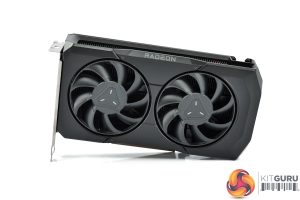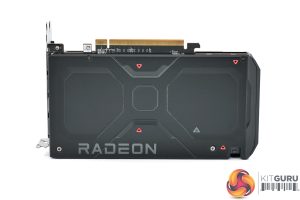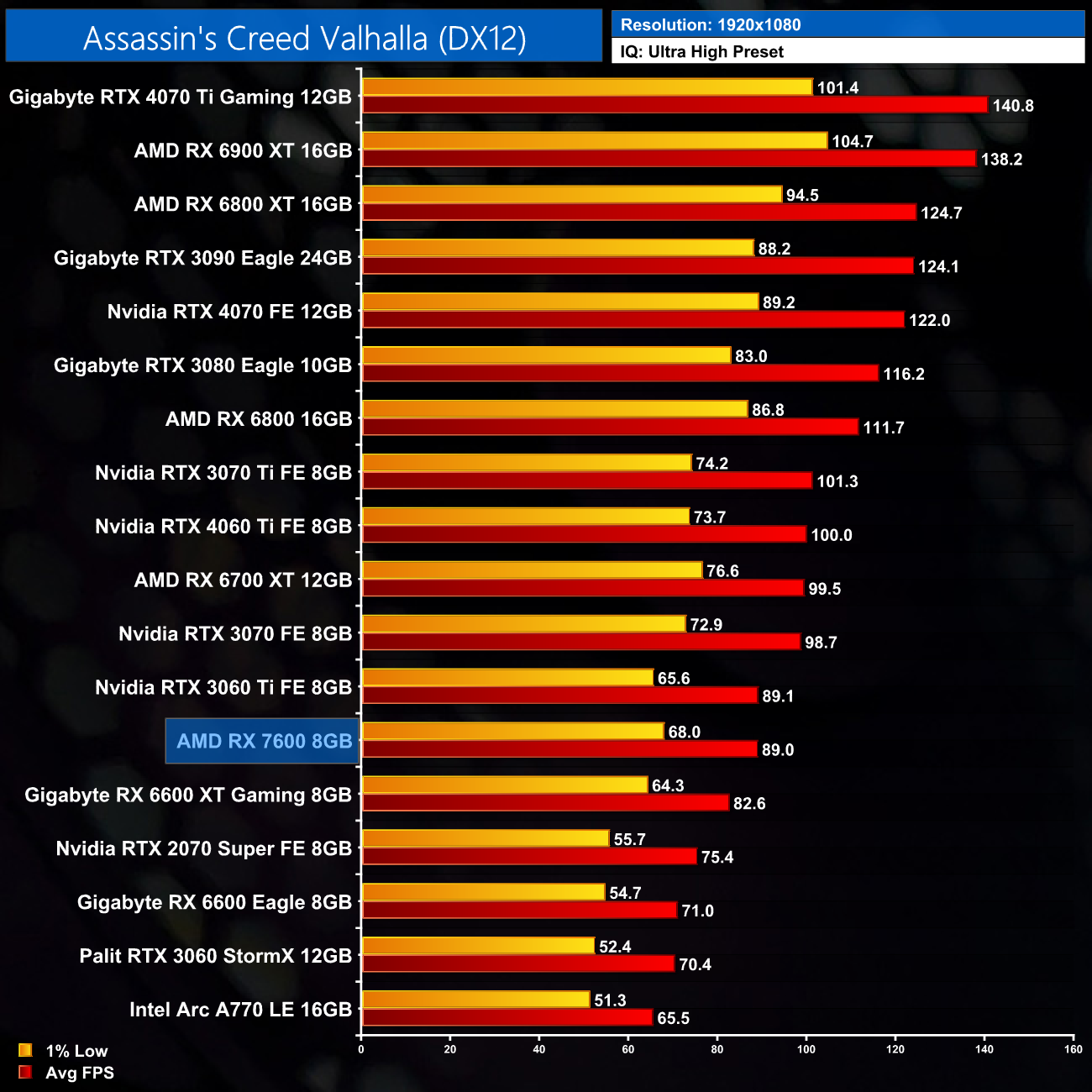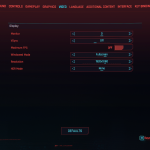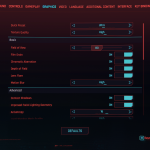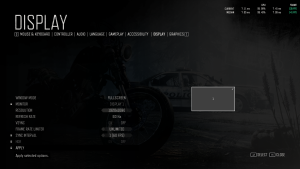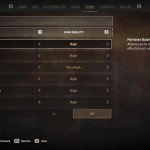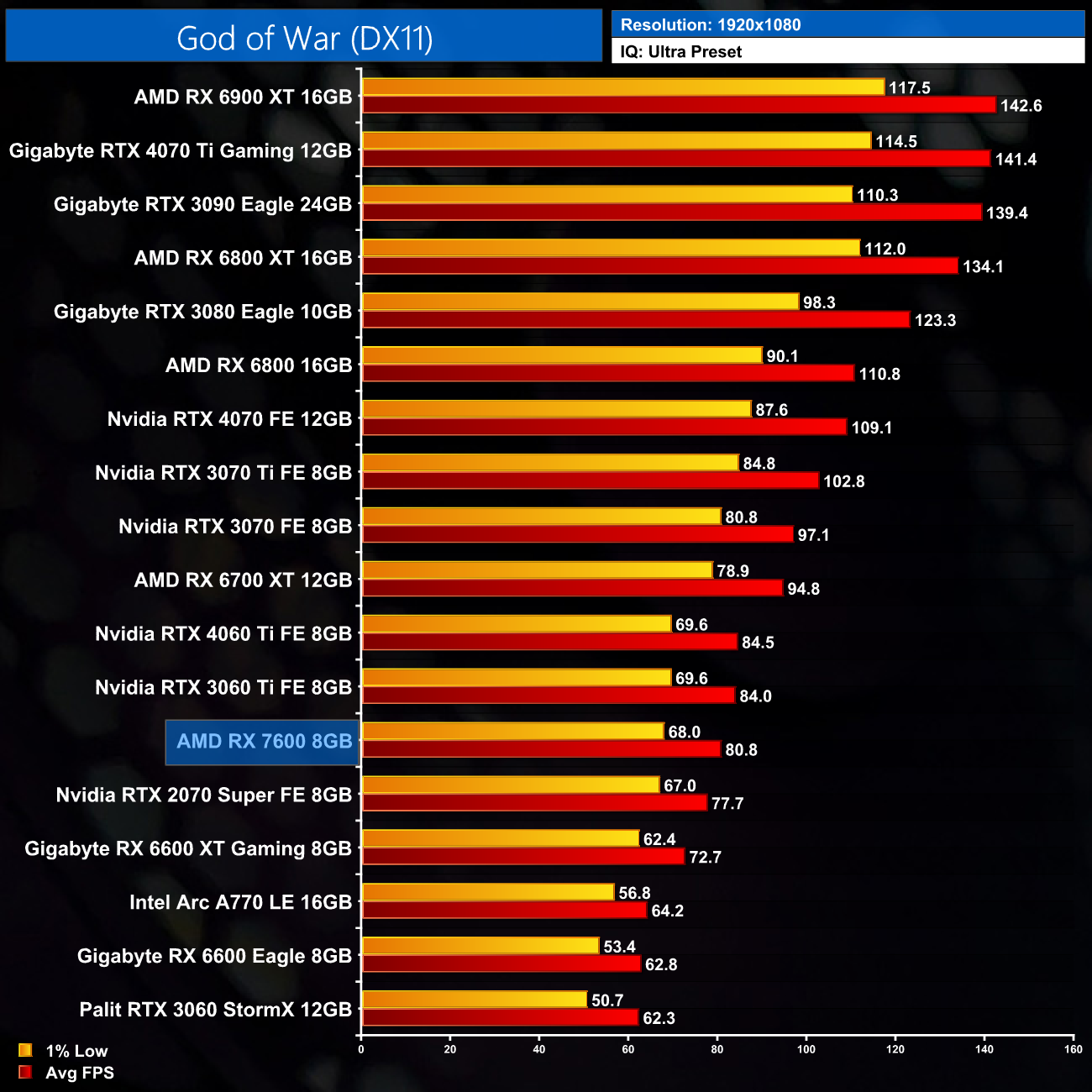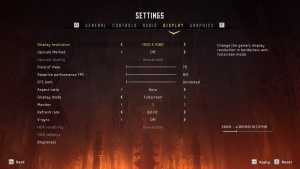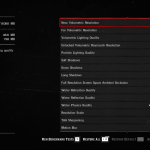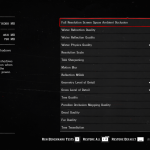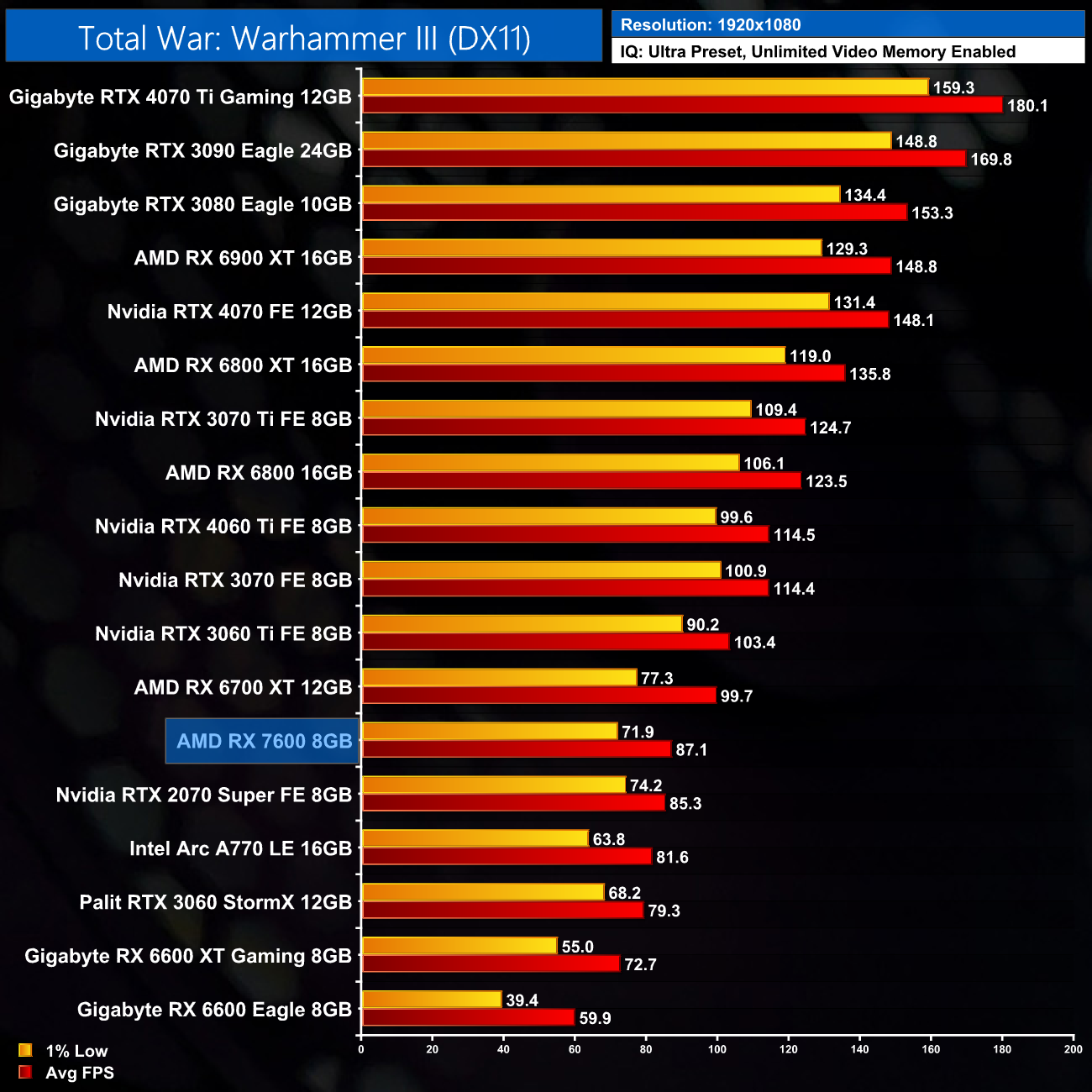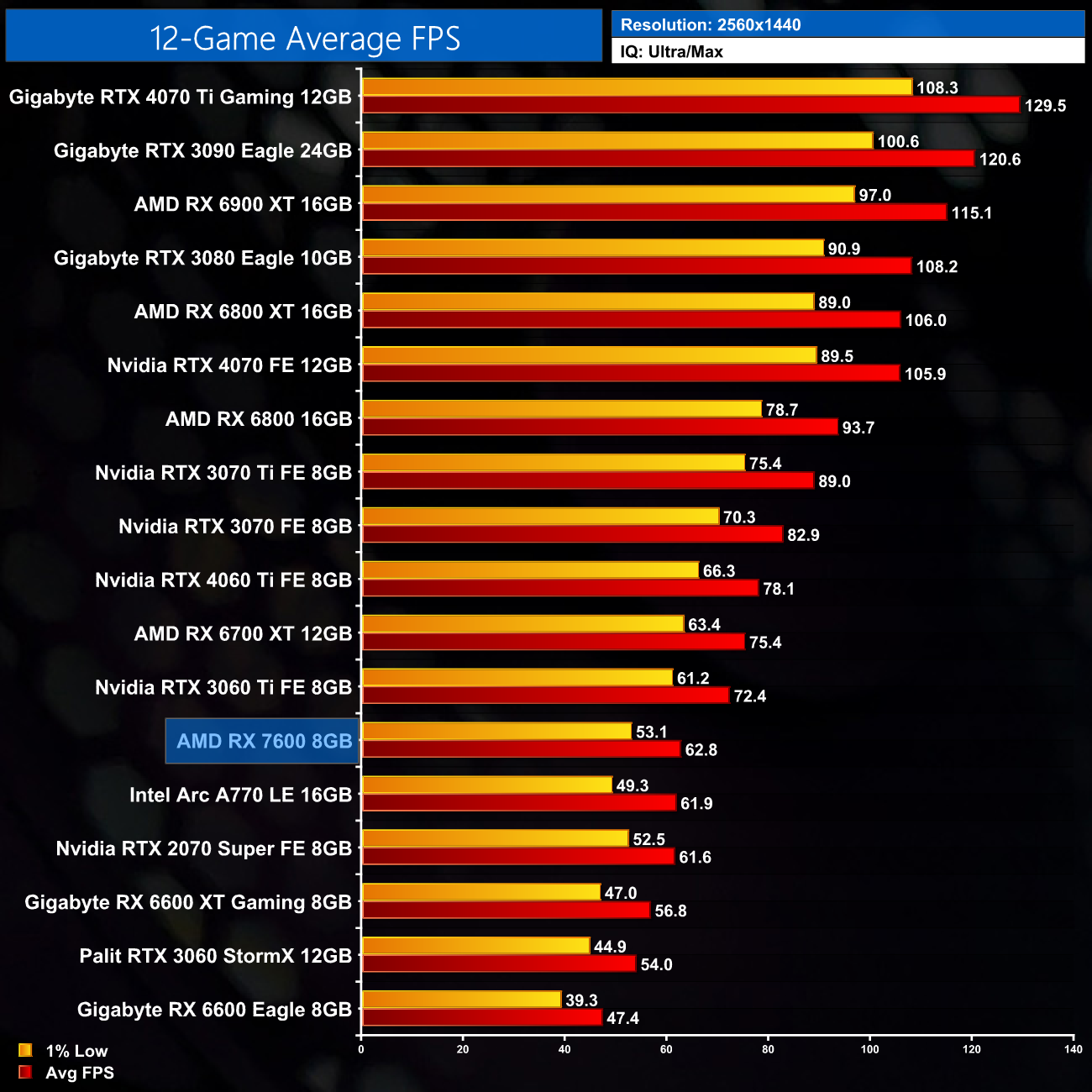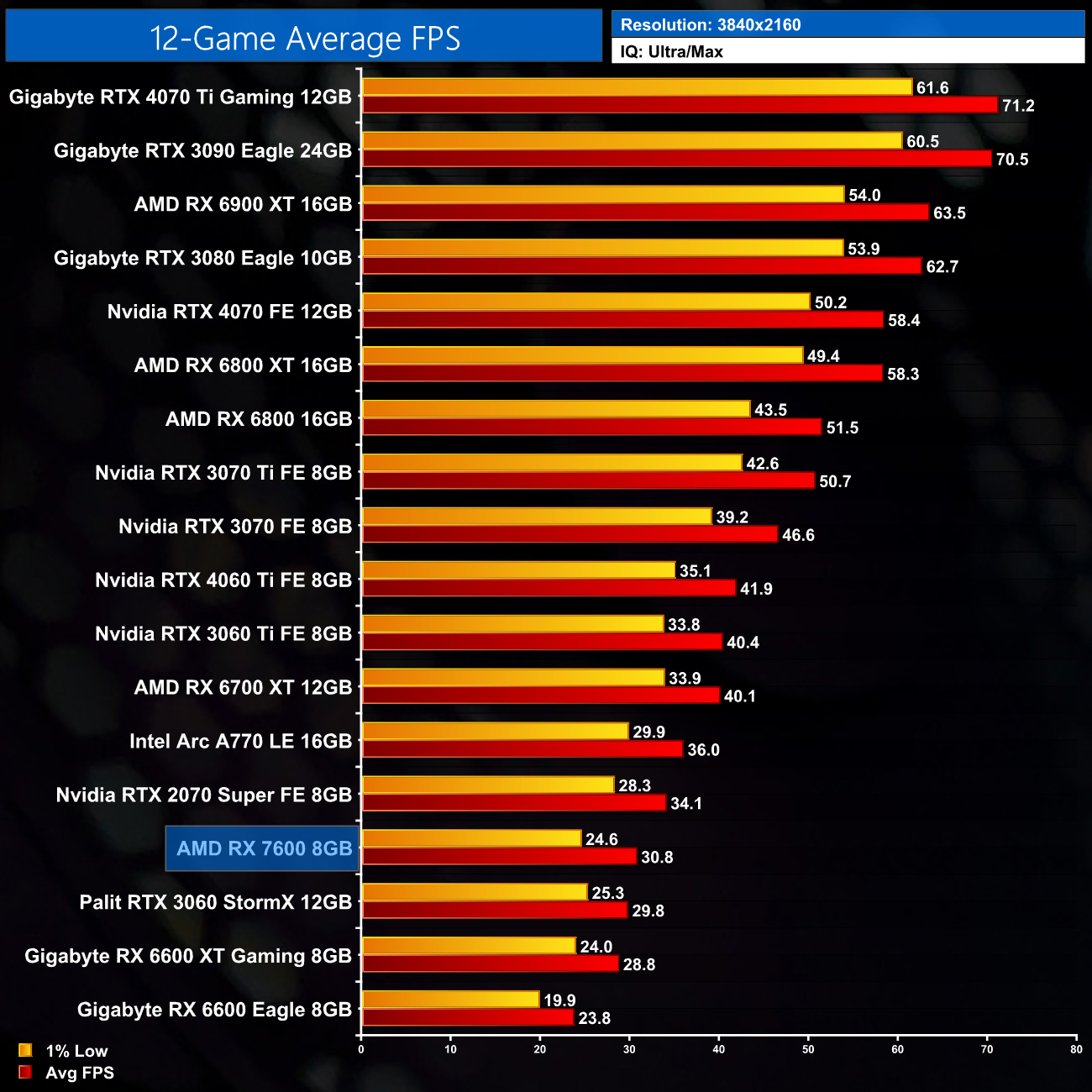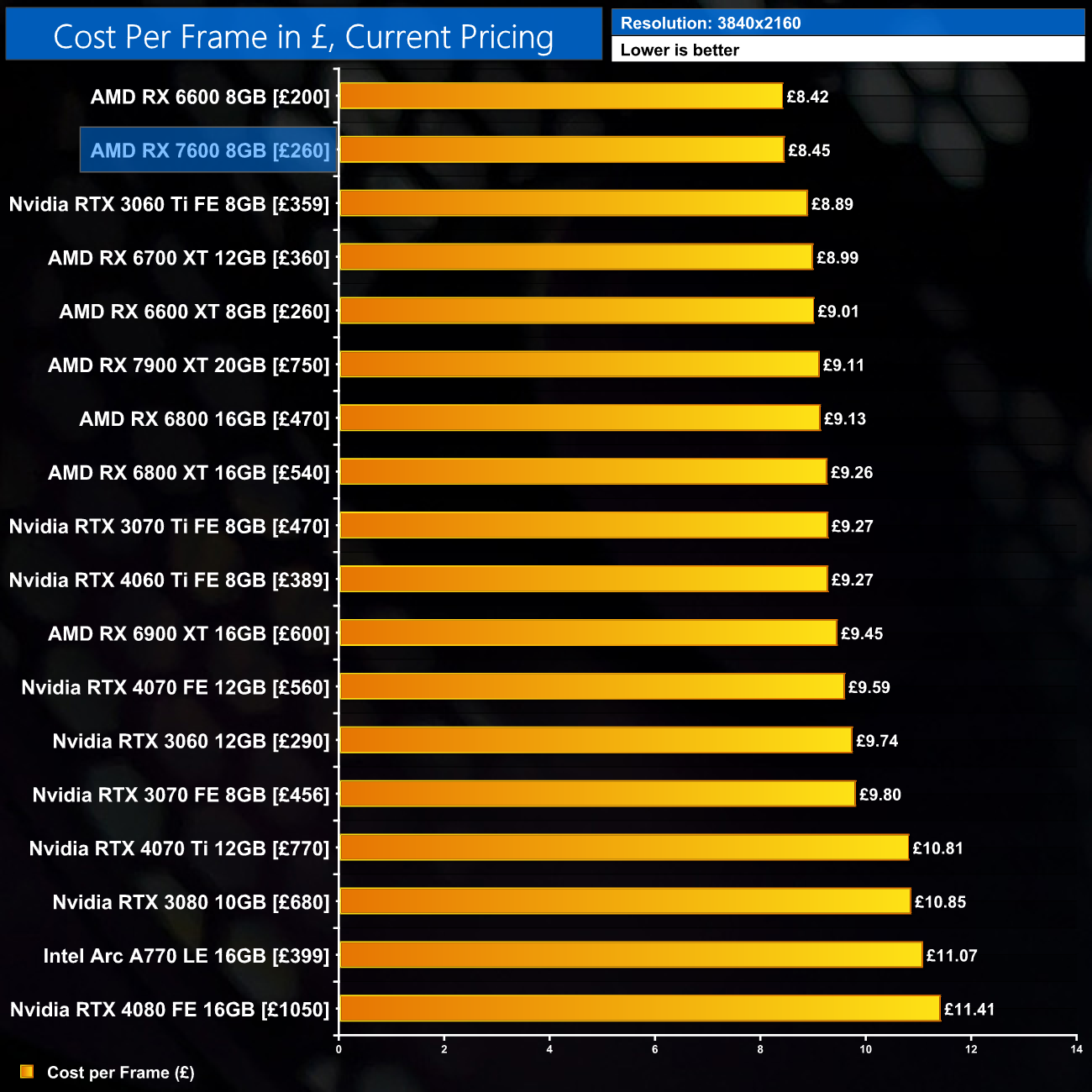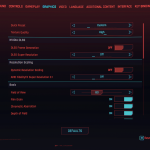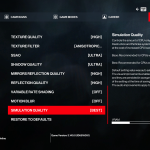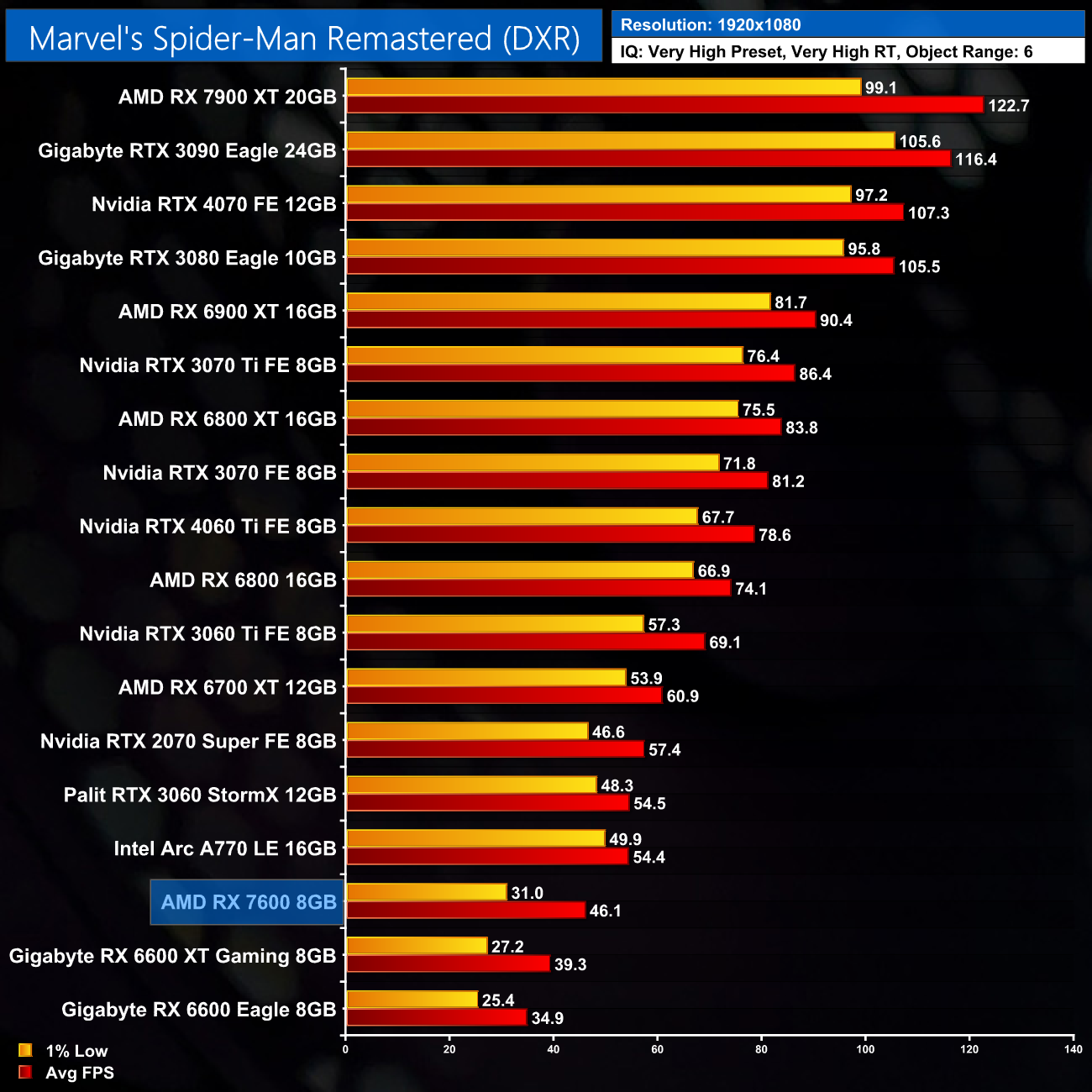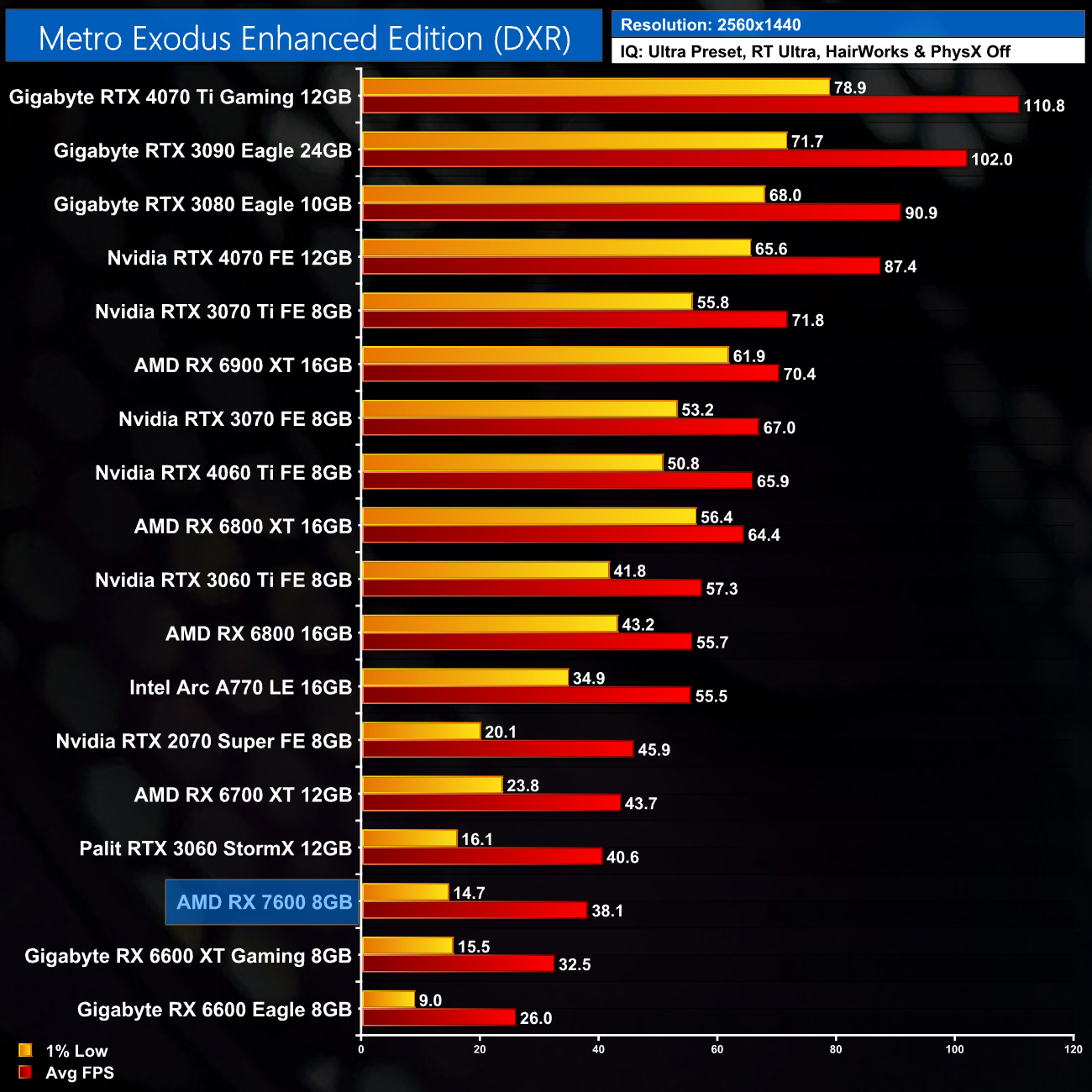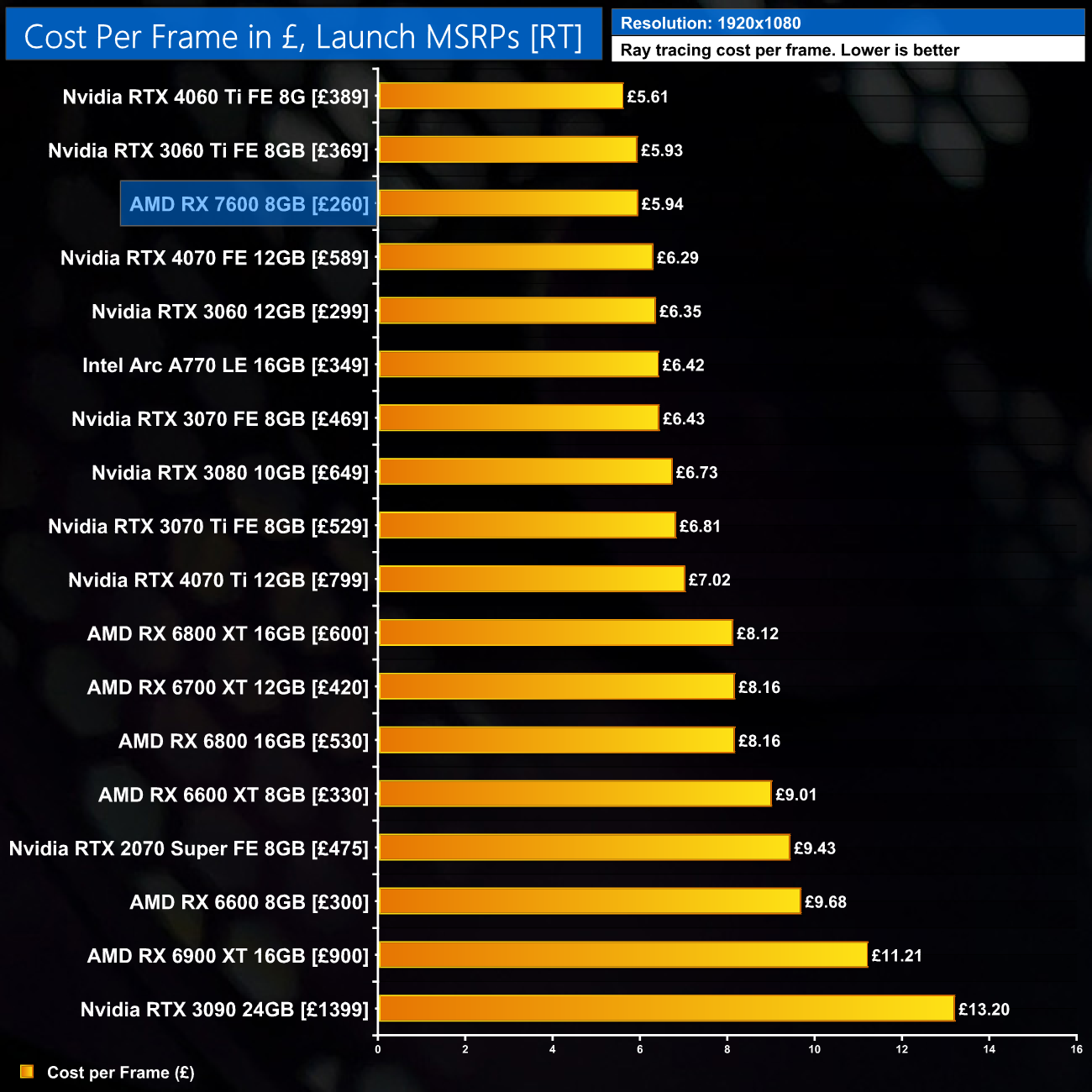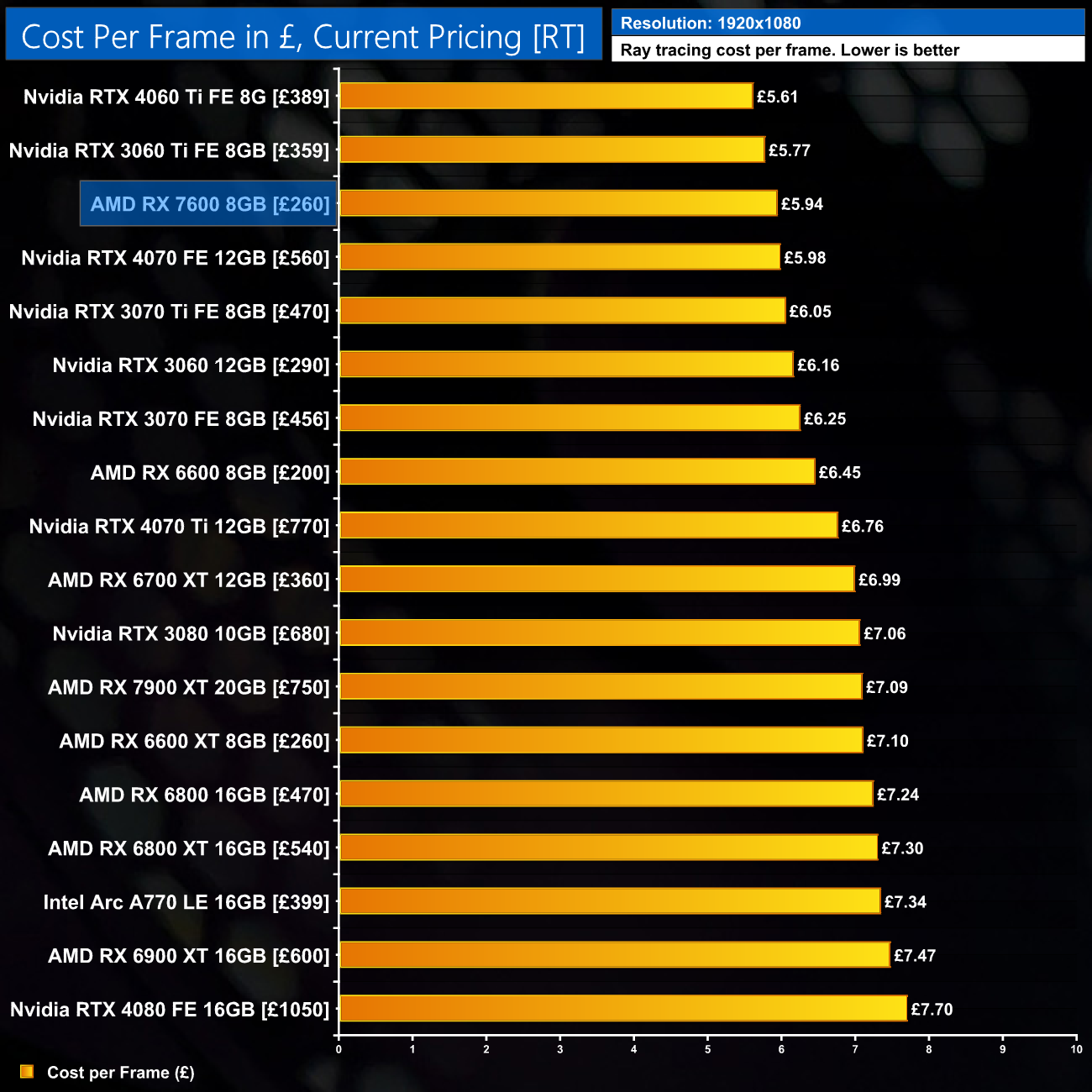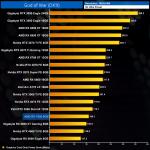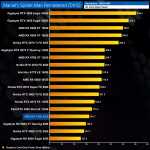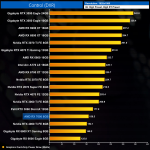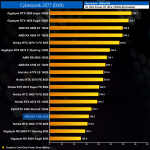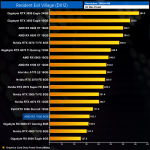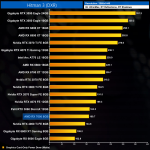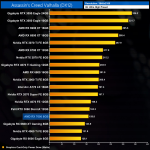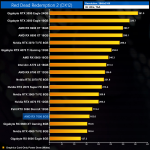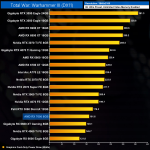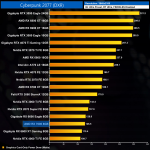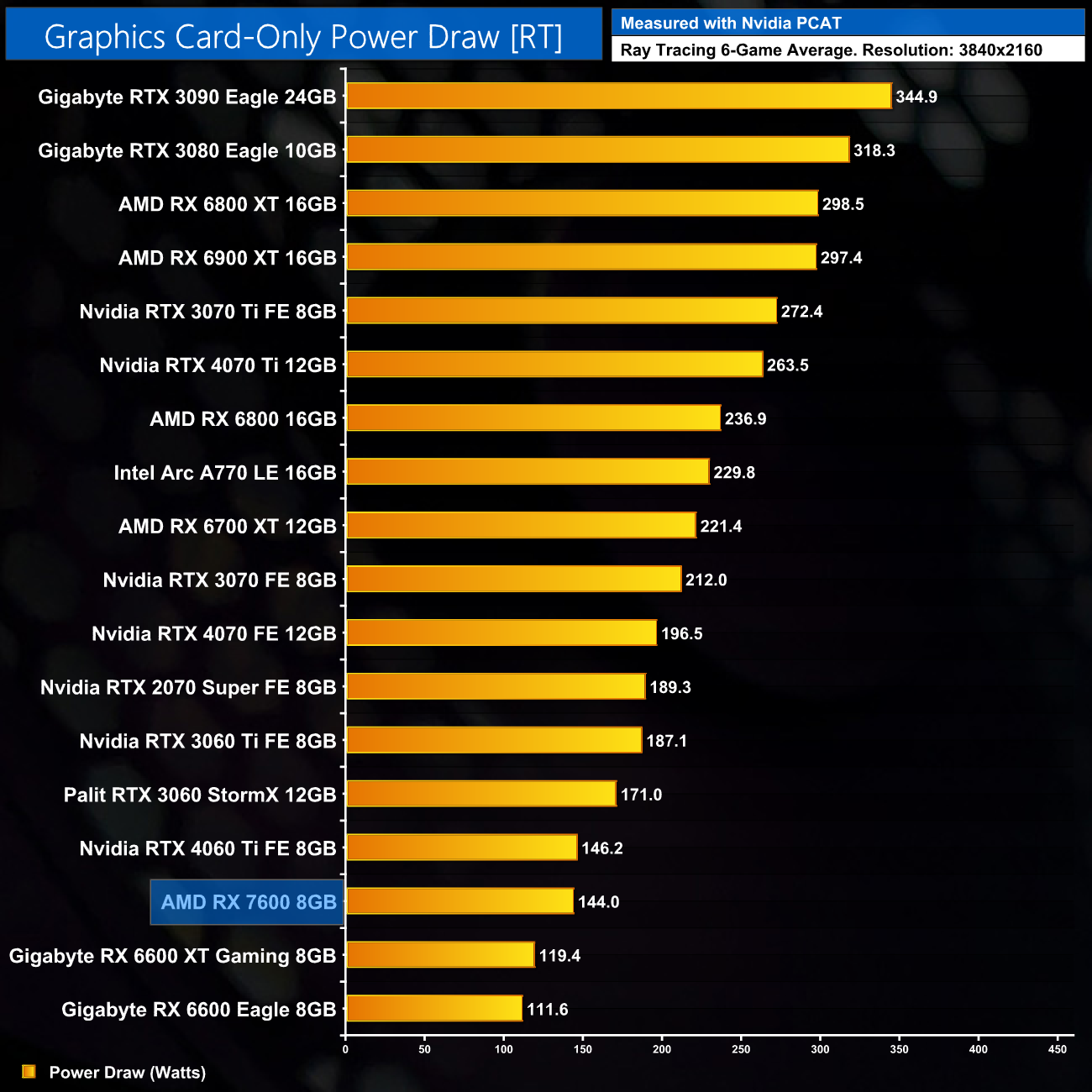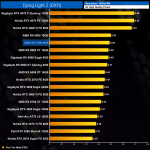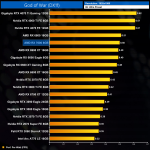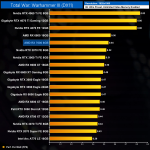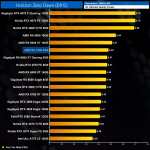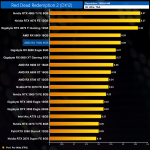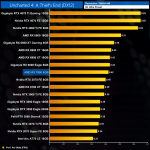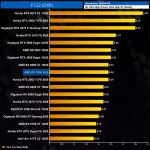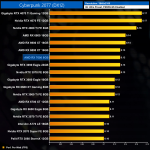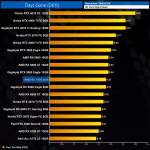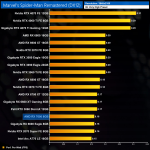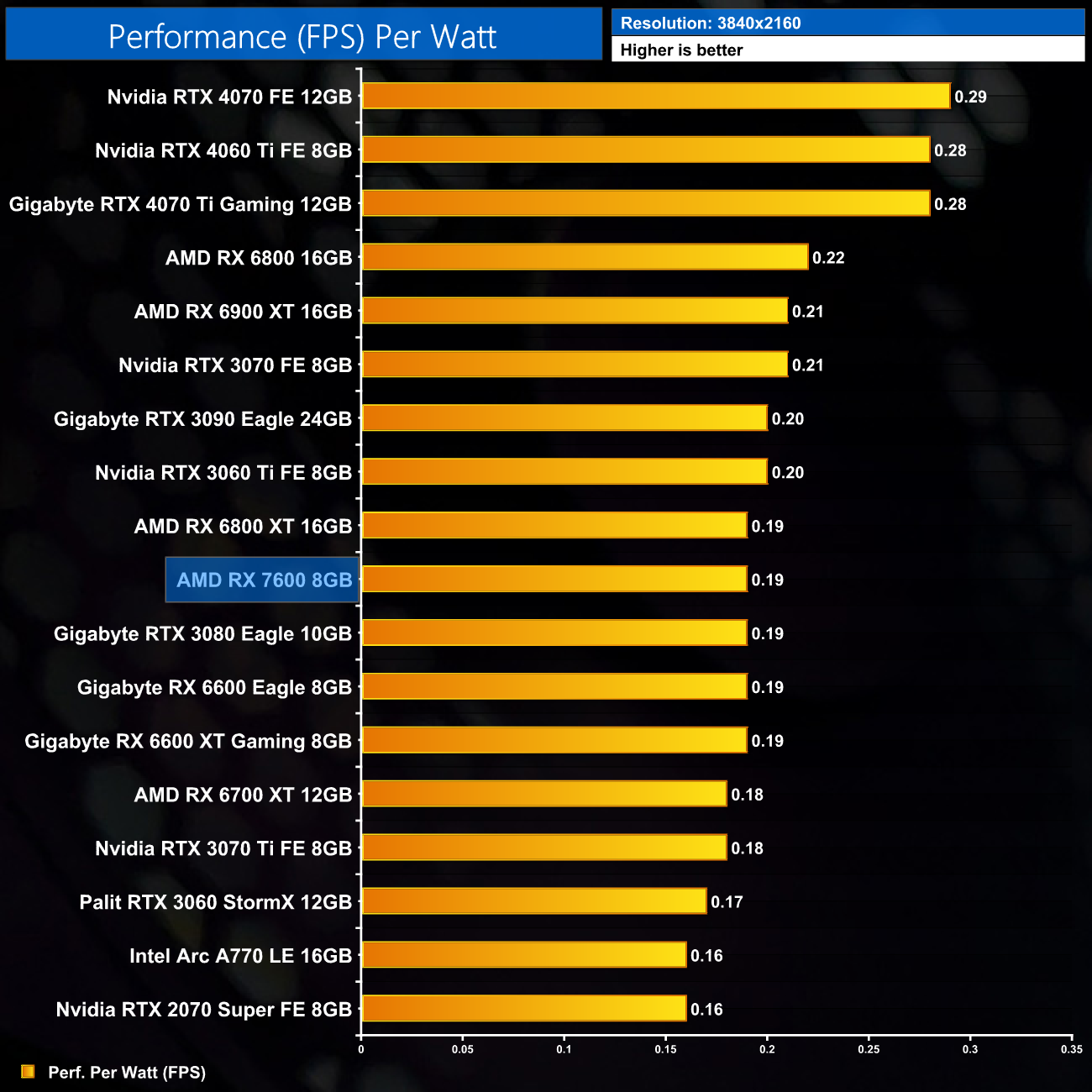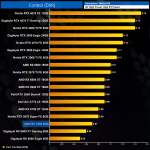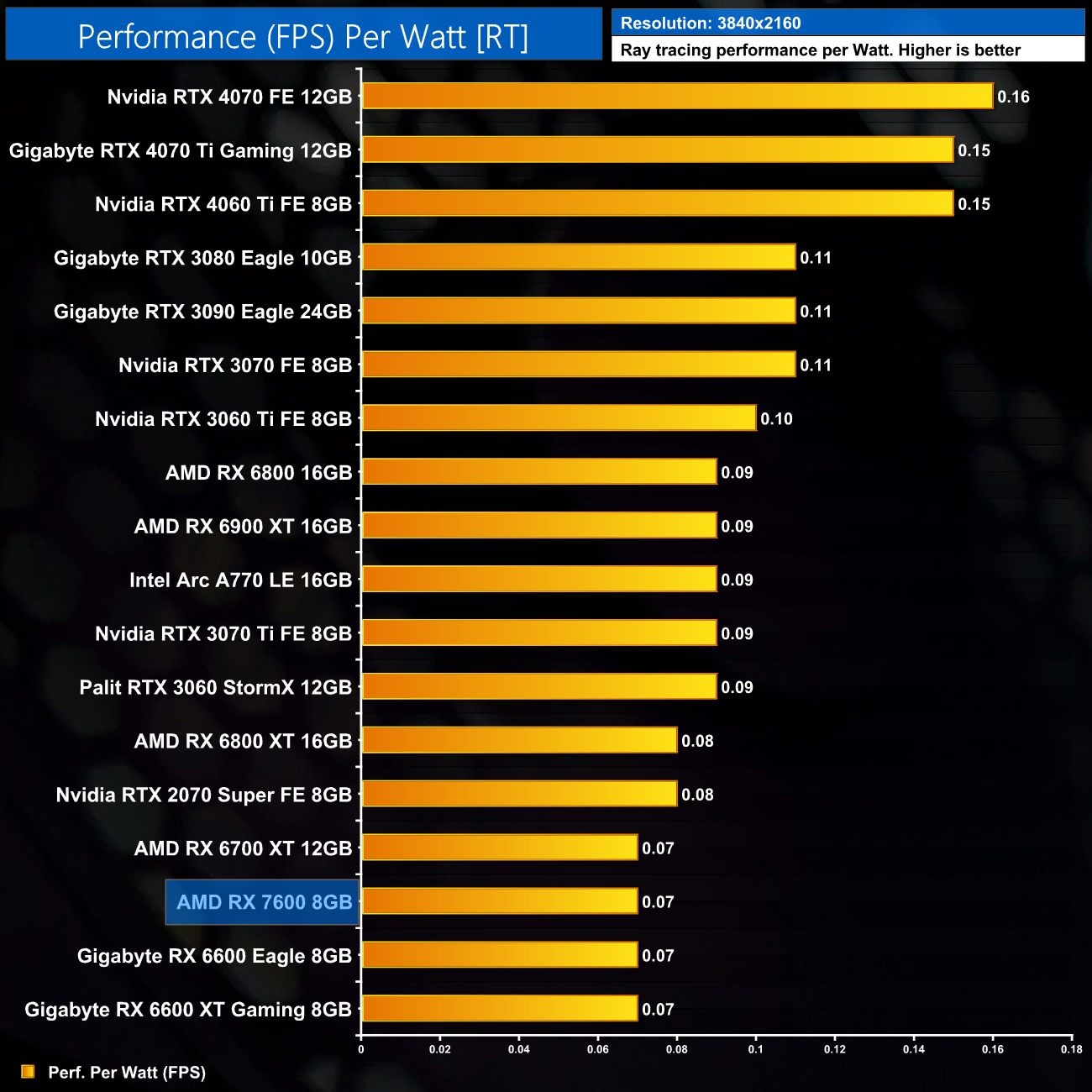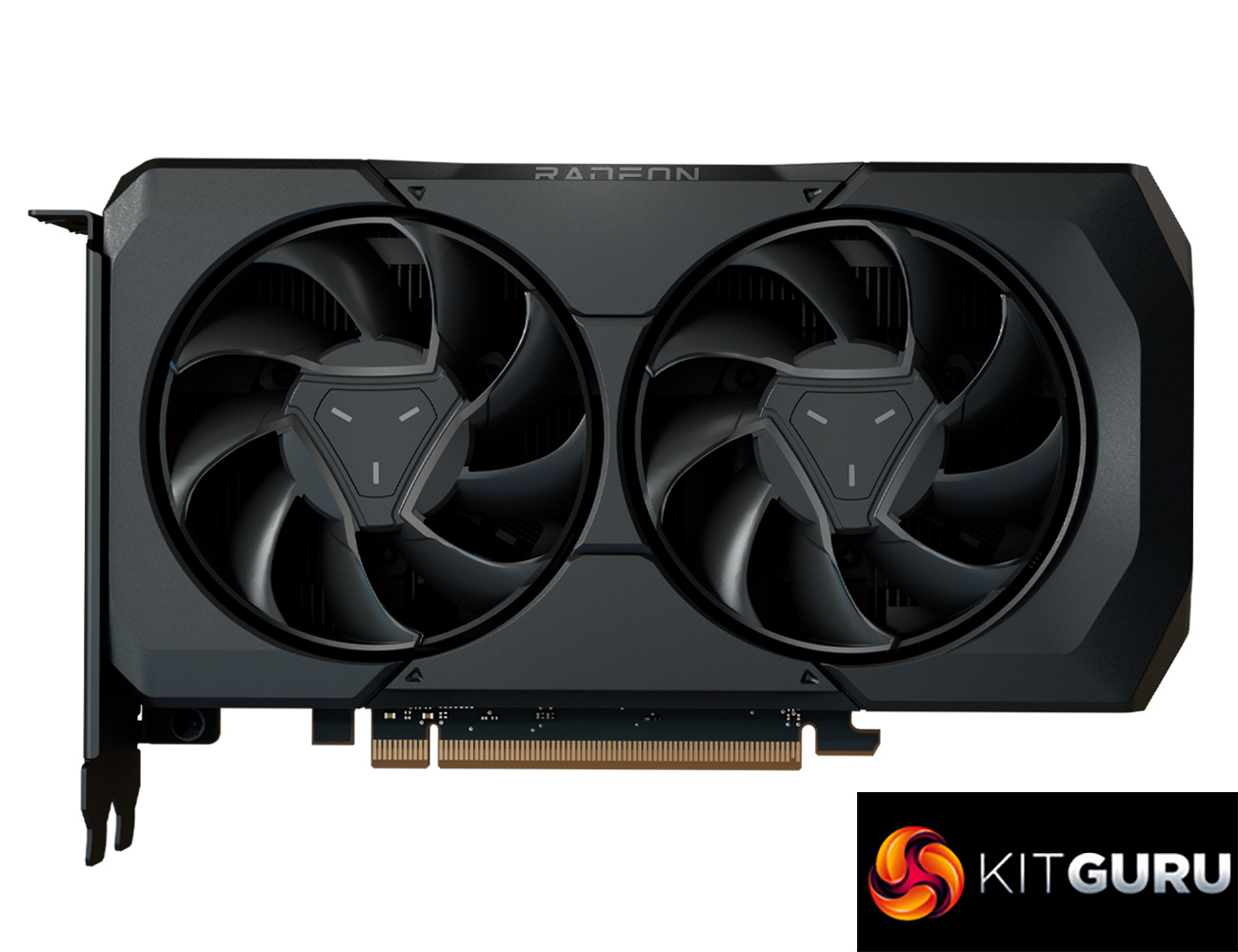
There's a saying in London that you might wait ages for a bus, and then two come along at once. This week, that scenario has played out perfectly in the GPU space, with Nvidia releasing the RTX 4060 Ti 8GB yesterday, and that is followed today by AMD's RX 7600. Claimed to be 29% faster than the RX 6600, but with a lower MSRP at launch, we test gaming performance, ray tracing, power draw, efficiency and more in this review.
Things have been quiet at AMD's GPU division for several months now, with no new releases since the launch of the RX 7900 XTX and 7900 XT. That changes today however, as the RX 7600 has been officially announced, with retail availability from tomorrow, May 25th.
Initially targeting a £289.99/$299 MSRP, just yesterday AMD confirmed to us that the RX 7600 will in fact retail from £259.99/$269, making it £40 cheaper than the RX 6600 it replaces, at least based on the launch MSRP. RDNA 2 GPUs are now selling well below MSRP however, so there's only one thing left to do – let's benchmark this new GPU and find out how it compares…
If you want to read this review as a single page, click HERE.
| RX 6700 XT | RX 6650 XT | RX 6600 XT | RX 6600 | RX 7600 | |
| Architecture | RDNA 2 | RDNA 2 | RDNA 2 | RDNA 2 | RDNA 3 |
| Manufacturing Process | 7nm | 7nm | 7nm | 7nm | 6nm |
| Transistor Count | 17.2 billion | 11.1 billion | 11.1 billion | 11.1 billion | 13.3 billion |
| Die Size | 336 mm² | 237 mm² | 237 mm² | 237 mm² | 204 mm² |
| Compute Units | 40 | 32 | 32 | 28 | 32 |
| Ray Accelerators | 40 | 32 | 32 | 28 | 32 |
| Stream Processors | 2560 | 2048 | 2048 | 1792 | 2048 |
| Game GPU Clock | Up to 2424MHz | Up to 2410MHz | Up to 2359MHz | Up to 2044 MHz | 2250 MHz |
| Boost GPU Clock | Up to 2581MHz | Up to 2635MHz | Up to 2589MHz | Up to 2491MHz | Up to 2625MHz |
| ROPs | 64 | 64 | 64 | 64 | 64 |
| AMD Infinity Cache | 96MB | 32MB | 32MB | 32MB | 32MB |
| Memory | 12GB GDDR6 16Gbps | 8GB GDDR6 17.5Gbps | 8GB GDDR6 16Gbps | 8GB GDDR6 14Gbps | 8GB GDDR6 18Gbps |
| Memory Bandwidth | 384 GB/s | 280 GB/s | 256 GB/s | 224 GB/s | 288 GB/s |
| Memory Interface | 192-bit | 128-bit | 128-bit | 128-bit | 128-bit |
| Board Power | 230W | 180W | 160W | 132W | 165W |
First, let's take a quick look at the specs. Still based on the RDNA 3 architecture, things are slightly different to what we saw with the RX 7900 XTX and 7900 XT. For one, the chiplet-based design has reverted to a monolithic die, and instead of using TSMC's 5nm process, Navi 33 makes use of 6nm, with a 204 mm² die size.
Internally though, the compute makeup hasn't been radically changed. Navi 33 packs in 32 Compute Units, each of which houses 64 Stream Processors, for a total of 2048 shaders. There's also 32 Ray Accelerators – one per CU – and 64 ROPs.
As for clock speed, this remains high with the RX 7600, with AMD touting a boost of up to 2625MHz, though a slightly lower game clock of 2250MHz.
Meanwhile, the memory configuration is almost identical to the previous generation RX 6600. We still find 8GB GDDR6 operating over a 128-bit interface, but this time the memory clocks in at 18Gbps, up from 14Gbps. This gives a memory bandwidth of 288 GB/s, though AMD claims an ‘effective' bandwidth of 476.9 GB/s due to the 32MB of 2nd Gen Infinity cache.
As with Navi 23, Navi 33 also features a cut-down PCIe interface, offering a Gen4 x8 connection.
Power draw for the RX 7600 is rated at 165W Total Board Power (TBP), an increase from the 132W figure for the RX 6600. We are using our updated GPU power testing methodology in this review, so read on for our most detailed power and efficiency testing yet.
The AMD RX 7600 ships in a compact box, with a semi-obscured image of the graphics card visible on the front. Inside we find just a few pieces of documentation, encouraging the user to scan a QR code to access the full quick-start guide and user manuals.
As for AMD's reference card, the overall design language is immediately recognisable from the RX 7900 XTX/XT. In fact, if you imagined those cards, but with one of the three fans lopped off, then you pretty much have the RX 7600.
That's no bad thing though, as it's a very well built card, with a black metal shroud and a distinct lack of colour giving it a stealthy appearance. Those two fans we can see measure 80mm in diameter.
It's a dinky little card too, measuring in at 116.1mm H, 203.2 x 116.1 x 40.6mm, so it's very ITX friendly and just two slots thick. While undeniably well built, it's not that heavy either, tipping the scales at 750g.
The front side of the card is home to the Radeon logo, and we can see just three of the heatsink fans have been painted red, as we saw on the 7900 XTX/XT reference cards.
The backplate is a full-length design, also made from metal, and it does not feature any cutouts to aid with airflow.
Power is delivered by a single 8-pin connector, while display outputs consist of 3x DisplayPort 2.1 and 1x HDMI 2.1. Do be aware that some RX 7600 AIB cards may not come with DisplayPort 2.1 connectors however, as AMD has left this area for its partners to decide what works best.
Driver Notes
- All AMD GPUs (except RX 7600) were benchmarked with the Adrenalin 23.3.2 driver.
- All Nvidia GPUs (except RTX 4070) were benchmarked with the 531.41 driver.
- All Intel GPUs were benchmarked with the 101.4314 driver.
- RTX 4070 was benchmarked with the 531.42 driver supplied to press.
- RTX 4060 Ti was benchmarked with the 531.93 driver supplied to press.
- RX 7600 was benchmarked with the driver supplied to press.
Test System:
We test using a custom built system from PCSpecialist, based on Intel’s Rocket Lake platform. You can read more about this system HERE and configure your own PCSpecialist system HERE.
| CPU |
Intel Core i9-13900KS
|
| Motherboard |
Gigabyte Z790 Gaming X AX
|
| Memory |
32GB (2x16GB) Corsair Dominator Platinum RGB DDR5 6000MHz
|
| Graphics Card |
Varies
|
| SSD |
4TB Seagate Firecuda 530 Gen 4 PCIe NVMe
|
| Chassis | Corsair 5000D Airflow Tempered Glass Gaming Case |
| CPU Cooler |
Corsair iCUE H150i Elite RGB High Performance CPU Cooler
|
| Power Supply |
Corsair 1600W Pro Series Titanium AX1600i Digital Modular PSU
|
| Operating System |
Windows 11 22H2
|
| Monitor |
MSI Optix MPG321UR-QD
|
| Resizable BAR |
Enabled for all supported GPUs
|
Comparison Graphics Cards List
- AMD RX 7900 XT 20GB
- AMD RX 6900 XT 16GB
- AMD RX 6800 XT 16GB
- AMD RX 6800 16GB
- AMD RX 6700 XT 12GB
- Gigabyte RX 6600 XT Gaming 8GB
- Gigabyte RX 6600 Eagle 8GB
- Intel Arc A770 LE 16GB
- Gigabyte RTX 4070 Ti Gaming 12GB
- Nvidia RTX 4070 Founders Edition 12GB
- Nvidia RTX 4060 Ti Founders Edition 8GB
- Gigabyte RTX 3090 Ti Gaming 24GB
- Gigabyte RTX 3090 Eagle 24GB
- Gigabyte RTX 3080 Eagle 10GB
- Nvidia RTX 3070 Ti FE 8GB
- Nvidia RTX 3070 FE 8GB
- Nvidia RTX 3060 Ti FE 8GB
- Palit RTX 3060 StormX 12GB
- Nvidia RTX 2070 Super FE 8GB
All cards were tested at reference specifications.
Software and Games List
- 3DMark Fire Strike & Fire Strike Ultra (DX11 Synthetic)
- 3DMark Time Spy (DX12 Synthetic)
- 3DMark DirectX Raytracing feature test (DXR Synthetic)
- Assassin's Creed Valhalla (DX12)
- Control (DXR)
- Cyberpunk 2077 (DX12)
- Days Gone (DX11)
- Dying Light 2 (DX11)
- F1 22 (DXR)
- God of War (DX11)
- Hitman 3 (DXR)
- Horizon Zero Dawn (DX12)
- Marvel's Spider-Man Remastered (DX12)
- Metro Exodus Enhanced Edition (DXR)
- A Plague Tale: Requiem (DX12)
- Red Dead Redemption 2 (DX12)
- Resident Evil Village (DX12)
- Total War: Warhammer III (DX11)
- Uncharted 4: A Thief's End (DX12)
We run each benchmark/game three times, and present mean averages in our graphs. We use FrameView to measure average frame rates as well as 1% low values across our three runs.
Fire Strike is a showcase DirectX 11 benchmark for modern gaming PCs. Its ambitious real-time graphics are rendered with detail and complexity far beyond other DirectX 11 benchmarks and games. Fire Strike includes two graphics tests, a physics test and a combined test that stresses the CPU and GPU. (UL).
3DMark Time Spy is a DirectX 12 benchmark test for Windows 10 gaming PCs. Time Spy is one of the first DirectX 12 apps to be built the right way from the ground up to fully realize the performance gains that the new API offers. With its pure DirectX 12 engine, which supports new API features like asynchronous compute, explicit multi-adapter, and multi-threading, Time Spy is the ideal test for benchmarking the latest graphics cards. (UL).
Early performance indicators in 3DMark show see the RX 7600 coming in 35-36% higher than the RX 6600 in Fire Strike and Time Spy. It's even 14% ahead of the RX 6600 XT in the latter benchmark.
Real-time ray tracing is incredibly demanding. The latest graphics cards have dedicated hardware that’s optimised for ray-tracing. The 3DMark DirectX Raytracing feature test measures the performance of this dedicated hardware. Instead of using traditional rendering techniques, the whole scene is ray-traced and drawn in one pass. The result of the test depends entirely on ray-tracing performance. (UL).
Ray tracing performance in the DXR feature test is very punishing, but the RX 7600 shows a significant 54% uplift versus the RX 6600, indicating a hefty increase in ray tracing performance.
Assassin's Creed Valhalla is an action role-playing video game developed by Ubisoft Montreal and published by Ubisoft. It is the twelfth major instalment and the twenty-second release in the Assassin's Creed series, and a successor to the 2018's Assassin's Creed Odyssey. The game was released on November 10, 2020, for Microsoft Windows, PlayStation 4, Xbox One, Xbox Series X and Series S, and Stadia, while the PlayStation 5 version was released on November 12. (Wikipedia).
Engine: AnvilNext 2.0. We test using the Ultra High preset, DX12 API.
Kicking off our game benchmarks with Assassin's Creed Valhalla, at 1080p the RX 7600 delivers 89FPS on average, and that puts it dead level with the RTX 3060 Ti. It's also outperforming the RX 6600 by 25%, and is even 8% ahead of the RX 6600 XT.
1440p is very playable too, with an average of 66FPS. The 7600 has fallen behind the RTX 3060 Ti here, likely due to memory bandwidth constraints, but it's still a good 11% faster than the RX 6600 XT.
Cyberpunk 2077 is a 2020 action role-playing video game developed and published by CD Projekt. The story takes place in Night City, an open world set in the Cyberpunk universe. Players assume the first-person perspective of a customisable mercenary known as V, who can acquire skills in hacking and machinery with options for melee and ranged combat. Cyberpunk 2077 was released for Microsoft Windows, PlayStation 4, Stadia, and Xbox One on 10 December 2020. (Wikipedia).
Engine: REDengine 4. We test using the Ultra preset, FSR disabled, DX12 API.
Performance in Cyberpunk 2077 also exceeded my expectations, with a 79FPS average at 1080p Ultra settings. Again that's just 4% below the 3060 Ti, while outstripping the 6600 XT by a 13% margin.
1440p is still relatively playable too, with an average of 50FPS exactly, which translates to a pretty decent 41% lead over the RX 6600, and an 18% uplift versus the 6600 XT.
Days Gone is a 2019 action-adventure survival horror video game developed by Bend Studio and published by Sony Interactive Entertainment for the PlayStation 4 and Microsoft Windows. As part of Sony's efforts to bring more of its first-party content to Microsoft Windows following Horizon Zero Dawn, Days Gone released on Windows on May 18, 2021. (Wikipedia).
Engine: Unreal Engine 4. We test using the Very High preset, DX11 API.
The RX 7600 can't keep pace with the RTX 3060 Ti quite so well in Days Gone, even with 98FPS on average, it's 22% slower than the Nvidia GPU, with only minimal improvements over the RX 6600 XT and RTX 3060 12GB.
Again, still a pretty good experience at 1440p however, where it's 25% faster than the RX 6600, but thin 4% of the RX 6600 XT.
Dying Light 2: Stay Human is a 2022 action role-playing game developed and published by Techland. The sequel to Dying Light (2015), the game was released on February 4, 2022 for Microsoft Windows, PlayStation 4, PlayStation 5, Xbox One, and Xbox Series X/S. (Wikipedia).
Engine: C-Engine. We test using the High preset, DX11 API.
The RX 7600 delivers more solid results in Dying Light 2, where at 1080p its average of 79FPS translates to a 7% lead over the RX 6600 XT, and it's 20% faster than the RTX 3060.
1440p sees the gap between the 7600 and 6600 XT shrink to just 6%, while the RTX 3060 also catches up somewhat, with the 7600 now 15% faster compared to the 20% lead it held at 1080p.
God of War is an action-adventure game developed by Santa Monica Studio and published by Sony Interactive Entertainment (SIE). It was released worldwide on April 20, 2018, for the PlayStation 4 with a Microsoft Windows version released on January 14, 2022. (Wikipedia).
Engine: Sony Santa Monica in-house engine. We test using the Ultra preset, DX11 API.
God of War showed us pretty awful scaling for the RTX 4060 Ti, so AMD's RX 7600 is actually within 4% of Nvidia's new GPU – not bad considering it's also over £100 cheaper!
It does fall off slightly at 1440p, now coming in 10% slower than the 4060 Ti, but that's still an excellent result for the 7600, and it's very playable at a near-locked 60FPS.
Horizon Zero Dawn is an action role-playing game developed by Guerrilla Games and published by Sony Interactive Entertainment. The plot follows Aloy, a hunter in a world overrun by machines, who sets out to uncover her past. It was released for the PlayStation 4 in 2017 and Microsoft Windows in 2020. (Wikipedia).
Engine: Decima. We test using the Ultimate Quality preset, DX12 API.
Up next is Horizon Zero Dawn, a now slightly older game that runs very well on a lot of hardware – we're getting over 100FPS at 1080p maximum settings, and that's a 31% uplift versus the RX 6600.
1440p is no problem either, the 7600 is 32% faster than the 6600, and 10% ahead of the 6600 XT, though it's not massively faster than the RTX 3060 here.
Marvel's Spider-Man Remastered is a 2018 action-adventure game developed by Insomniac Games and published by Sony Interactive Entertainment. A remastered version of Marvel's Spider-Man, featuring all previously released downloadable content, was released for the PlayStation 5 in November 2020 and for Microsoft Windows in August 2022. (Wikipedia).
Engine: Insomniac Games in-house engine. We test using the Very High preset, DX12 API.
If you want to do some web slinging, the RX 7600 provides a smooth 81FPS at 1080p, delivering a not insignificant 38% uplift versus the 6600, although it doesn't hold much of a lead over the RTX 3060.
At 1440p it's still reasonable, coming in just a touch behind Intel's A770, while we can also note a 14% gain versus the RX 6600 XT.
A Plague Tale: Requiem is an action-adventure stealth game developed by Asobo Studio and published by Focus Entertainment. It is the sequel to A Plague Tale: Innocence (2019), and follows siblings Amicia and Hugo de Rune who must look for a cure to Hugo's blood disease in Southern France while fleeing from soldiers of the Inquisition and hordes of rats that are spreading the black plague. The game was released for Nintendo Switch, PlayStation 5, Windows, and Xbox Series X/S on 18 October 2022. (Wikipedia).
Engine: Asobo Studio in-house engine. We test using the Ultra preset, DX12 API.
A Plague Tale: Requiem is a stern test for any GPU, and the RX 7600 is reduced to just 52FPS for 1080p ultra settings. That again puts it level with the A770, but with slightly better 1% lows.
At 1440p I personally would be looking to lower the settings too, with an average frame rate of just 38FPS, although that is still a solid 38% improvement over the 6600.
Red Dead Redemption 2 is a 2018 action-adventure game developed and published by Rockstar Games. The game is the third entry in the Red Dead series and is a prequel to the 2010 game Red Dead Redemption. Red Dead Redemption 2 was released for the PlayStation 4 and Xbox One in October 2018, and for Microsoft Windows and Stadia in November 2019. (Wikipedia).
Engine: Rockstar Advance Game Engine (RAGE). We test by manually selecting Ultra settings (or High where Ultra is not available), TAA, DX12 API.
Red Dead Redemption 2 is a best case scenario for the RX 7600, it scales incredibly well here against the competition, beating out the 3060 Ti by a 7% margin, and it's only just behind the RTX 3070, which is impressive stuff considering the price point.
The 7600 can't quite maintain that level as we step up to 1440p – it's still very impressive, but holds just a 1% margin over the 3060 Ti, with reduced performance likely as a result of limited bandwidth that's more of a factor at higher resolutions.
Resident Evil Village is a survival horror game developed and published by Capcom. The sequel to Resident Evil 7: Biohazard (2017), players control Ethan Winters, who is searching for his kidnapped daughter; after a fateful encounter with Chris Redfield, he finds himself in a village filled with mutant creatures. The game was announced at the PlayStation 5 reveal event in June 2020 and was released on May 7, 2021, for Windows, PlayStation 4, PlayStation 5, Xbox One, Xbox Series X/S and Stadia. (Wikipedia).
Engine: RE Engine. We test using the Max preset, with V-Sync disabled, DX12 API.
Resident Evil Village continues the impressive scaling, with the 7600 once more within touching distance of the more expensive 3060 Ti. It's also delivering 32% more performance than the RX 6600.
1440p still sees the 7600 deliver over 115FPS, where it's a hair faster than the A770. Gains come in at 10% versus the RX 6600 XT.
Total War: Warhammer III is a turn-based strategy and real-time tactics video game developed by Creative Assembly and published by Sega. It is part of the Total War series, and the third to be set in Games Workshop's Warhammer Fantasy fictional universe (following 2016's Total War: Warhammer and 2017's Total War: Warhammer II). The game was announced on February 3, 2021 and was released on February 17, 2022.(Wikipedia).
Engine: TW Engine 3 (Warscape). We test using the Ultra preset, with unlimited video memory enabled, DX11 API.
Total War: Warhammer III delivers more solid results, the 7600 is bringing its biggest gains over the RX 6600 here, to the tune of 45% at 1080p – a pretty impressive gen-on-gen uplift.
At 1440p however, AMD GPUs seem to struggle a bit more with the 1% lows, but we're still looking at a 19% upgrade versus the RX 6600 XT.
Uncharted 4: A Thief's End is a 2016 action-adventure game developed by Naughty Dog and published by Sony Computer Entertainment. It is the fourth main entry in the Uncharted series. A remastered version, alongside The Lost Legacy as part of the Uncharted: Legacy of Thieves Collection, was released in January 2022 for PlayStation 5 and October 2022 for Windows. (Wikipedia).
Engine: Naughty Dog in-house engine. We test using the Ultra preset, DX12 API.
Finishing up the game benchmarks with Uncharted 4, with an average of 106FPS, we're looking at a smaller 20% uplift over the RX 6600, though coming in just 10% behind the RTX 3060 Ti isn't bad at all.
And then at 1440p, we're talking a 24% gain over the 6600, or a 6% lead over the RX 6600 XT.
Here we present frame rate figures for each graphics card, averaged across all 12 games on test today. These figures can disguise significant variations in performance from game to game, but provide a useful overview of the sort of performance you can expect at each resolution tested.
Overall, across the 12 games tested, AMD's RX 7600 delivers a 91FPS average frame rate, and that makes it a 31% improvement versus the RX 6600. It's only 10% slower than the RTX 3060 Ti, but 10% faster than the RX 6600 XT.
Reduced memory bandwidth does see the 7600 fall away from the 3060 Ti slightly, as it is now 13% slower on average at 1440p. That's still a decent 33% uplift over the 6600, or 11% compared to the RX 6600 XT.
The MSRPs
Using the average frame rate data presented earlier in the review, here we look at the cost per frame using the UK MSRP launch prices for each GPU.
Based on the £259 MSRP, the RX 7600 is the best value GPU we've tested. It offers an 18% reduction in cost per frame against its closest challenger, the RTX 4060 Ti, while it's 28% better value than the RX 6600 XT and 34% better than the RX 6600.
Current retail pricing
Of course, a lot of AMD GPUs are now selling well under MSRP, and this data based on current retail prices is more useful. With the RX 6600 retailing for just £200, the value proposition of both those GPUs is now identical. The RX 6600 XT is getting harder to find, but RX 6650 XTs – not shown in this chart – will also be knocking right on the door in terms of value as they start at £250.
Control is an action-adventure game developed by Remedy Entertainment and published by 505 Games. The game was released in August 2019 for PlayStation 4, Windows, and Xbox One, and for PlayStation 5 and Xbox Series X/S in February 2021. (Wikipedia).
Engine: Northlight Engine. We test using the High Preset, High Ray Tracing Preset, DXR API. DLSS/FSR are disabled.
As for ray tracing performance, we're starting off in Control, focusing on the 1080p data. The RX 7600 is less impressive here, coming in a touch slower than the RTX 3060, with an average of 52FPS. It's still a hefty upgrade over the 6600, delivering frame rates that are 40% better, but Nvidia's last gen offering is still superior here.
Cyberpunk 2077 is a 2020 action role-playing video game developed and published by CD Projekt. The story takes place in Night City, an open world set in the Cyberpunk universe. Players assume the first-person perspective of a customisable mercenary known as V, who can acquire skills in hacking and machinery with options for melee and ranged combat. Cyberpunk 2077 was released for Microsoft Windows, PlayStation 4, Stadia, and Xbox One on 10 December 2020. (Wikipedia).
Engine: REDengine 4. We test using the Ray Tracing: Ultra preset. DLSS/FSR are disabled. DXR API.
The same can be said for Cyberpunk 2077. At 1080p, Ultra ray tracing settings, the RX 7600 can't manage a playable frame rate – not even the RX 6700 XT can, with the RTX 3060 faster than both of those AMD GPUs.
F1 22 is a racing video game developed by Codemasters and published by EA Sports. It is the fifteenth entry in the F1 series by Codemasters. The game holds an official licence of the 2022 Formula One and Formula 2 championships. The game was released for PlayStation 4, PlayStation 5, Windows, Xbox One, and Xbox Series X/S on 1 July 2022. (Wikipedia).
Engine: EGO. We test using the Ultra High preset, Ultra High ray tracing quality, DXR API. DLSS/FSR are disabled.
F1 22 is slightly less demanding however, with the RX 7600 capable of a 60FPS average frame rate with every ray tracing setting enabled, which is on par with the Intel A770 and a 13% improvement over the 6600 XT.
Hitman 3 is a 2021 stealth game developed and published by IO Interactive. Hitman 3 was released worldwide for PlayStation 4, PlayStation 5, Windows, Xbox One, Xbox Series X/S, Stadia, and Nintendo Switch (via cloud gaming) on 20 January 2021. (Wikipedia).
Engine: Glacier engine. We test using Ultra settings, RT Reflections, RT Shadows, DXR API. DLSS/FSR are disabled.
Hitman 3 is another example of a game that's just too heavy for the RX 7600 using maximum ray tracing settings. It falters to just 25FPS on average, so you'd definitely want to reduce some settings or enable FSR here.
Marvel's Spider-Man Remastered is a 2018 action-adventure game developed by Insomniac Games and published by Sony Interactive Entertainment. A remastered version of Marvel's Spider-Man, featuring all previously released downloadable content, was released for the PlayStation 5 in November 2020 and for Microsoft Windows in August 2022. (Wikipedia).
Engine: Insomniac Games in-house engine. We test using the Very High preset, Very High RT, RT Object Range: 6. DXR API. DLSS/FSR are disabled.
Spider-Man Remastered is usually pretty amenable to AMD GPUs when enabling ray tracing, but the RX 7600 still struggles and is comprehensively out-muscled by the last-gen RTX 3060, with noticeably choppier 1% lows than that Nvidia GPU.
Metro Exodus is a first-person shooter video game developed by 4A Games and published by Deep Silver. An enhanced version of the game was released for Windows on 6 May 2021, and later for PlayStation 5 and Xbox Series X/S on 18 June 2021. (Wikipedia).
Engine: 4A Engine. We test using Ultra quality, Ultra ray tracing, ray traced reflections. HairWorks and Advanced PhysX are disabled. DXR API. DLSS/FSR are disabled.
Metro Exodus Enhanced Edition finishes our ray tracing benchmarks on a more positive note however, with the RX 7600 delivering an almost-locked 60FPS, with particularly smooth 1% lows. It's a huge 53% faster than the RX 6600, and 22% ahead of the 6600 XT.
Ray tracing 6-game average FPS
Overall then, the RX 7600 is certainly a much better ray tracing GPU than its predecessors, delivering 20% better performance on average compared to the RX 6600 XT. It's still no match for Nvidia here however, coming in 8% slower than the RTX 3060, and while it was just 10% slower than the 3060 Ti for rasterisation, it's 30% behind when looking at ray traced games.
Cost per frame, launch MSRP data
Even then, the £260 MSRP still helps the RX 7600 to offer reasonable value when looking at the ray tracing cost per frame, coming in level with the RTX 3060 Ti at 1080p – though it of course falls off at 1440p.
Cost per frame, current pricing data
We see similar results when looking at the value based on current prices – Nvidia GPUs have the upper hand here, not by much at 1080p, but by significant margins at 1440p.
Here we present the average clock speed for each graphics card while running Cyberpunk 2077 for 30 minutes. We use GPU-Z to record the GPU core frequency during gameplay. We calculate the average core frequency during the 30 minute run to present here.
Clock speed behaviour is very tight overall, with only small fluctuations in our testing. The RX 7600 averaged a frequency of 2552MHz across the 30 minute stress test.
For our temperature testing, we measure the peak GPU core temperature under load. A reading under load comes from running Cyberpunk 2077 for 30 minutes.
As for thermal performance, the dinky reference card is more than a match for the Navi 33 silicon. The GPU peaked at 71C, with the hot spot a touch warmer at 91C, but still within safe limits. We will shortly be testing the Sapphire Pulse model to see how it compares.
We take our noise measurements with the sound meter positioned 1 foot from the graphics card. I measured the noise floor to be 32 dBA, thus anything above this level can be attributed to the graphics cards. The power supply is passive for the entire power output range we tested all graphics cards in, while all CPU and system fans were disabled. A reading under load comes from running Cyberpunk 2077 for 30 minutes.
Noise levels are not a problem either. My testing saw the two fans run at 54%, or 1650rpm, over our thirty minute stress test, resulting in noise levels hitting 36dBa. I did notice some coil whine during my testing, but typically only in the in-game menus – during actual gameplay this was not a problem, and we include a sound test in our video review.
Here we present power draw figures for the graphics card-only, on a per-game basis for all twelve games we tested at 1080p. This is measured using Nvidia's Power Capture Analysis Tool, also known as PCAT. You can read more about our updated power draw testing methodology HERE.
Per-Game Results at 1080p:
Click to enlarge.
12-Game Average at 1080p:
As for power draw, AMD rates the RX 7600 with a 160W TBP, and that's almost exactly what we found in our own testing – over the 12 games benchmarked, 1080p power draw averaged 160.9W. That is still undeniably lower, but it's actually slightly higher than the RTX 4060 Ti we have just reviewed – and that GPU is a fair bit faster, so it will be interesting to see how the efficiency figures stack up.
Ray tracing results
As a bonus, we now include the power figures for all six games we test with ray tracing enabled.
6-Game ray tracing average:
Ray tracing power draw is almost identical too, averaging 159.5W.
Here we present power draw figures for the graphics card-only, on a per-game basis for all twelve games we tested at 1440p. This is measured using Nvidia's Power Capture Analysis Tool, also known as PCAT. You can read more about our updated power draw testing methodology HERE.
Per-Game Results at 1440p:
Click to enlarge.
12-Game Average at 1440p:
At 1440p, average power draw is broadly the same as it was at 1080p, now hitting 161.5W.
Ray tracing results
As a bonus, we now include the power figures for all six games we test with ray tracing enabled.
6-Game ray tracing average:
Ray tracing power has dropped back by 10W however, thanks to Cyberpunk which ground to an absolute halt with ray tracing enabled at 1440p – reducing power draw.
Here we present power draw figures for the graphics card-only, on a per-game basis for all twelve games we tested at 2160p (4K). This is measured using Nvidia's Power Capture Analysis Tool, also known as PCAT. You can read more about our updated power draw testing methodology HERE.
Per-Game Results at 2160p (4K):
Click to enlarge.
12-Game Average at 2160p (4K):
Lastly, power draw figures for 4K gaming may not be particularly relevant for this GPU, but we still see an average of 160.7W, so no real change compared to 1080p or 1440p.
Ray tracing results
As a bonus, we now include the power figures for all six games we test with ray tracing enabled.
6-Game ray tracing average:
Once more though, ray tracing power drops back as more of the 6 games tested barely exceeded single-digit FPS values.
Using the graphics card-only power draw figures presented earlier in the review, here we present performance per Watt on a per-game basis for all twelve games we tested at 1080p.
Per-Game Results at 1080p:
Click to enlarge.
12-Game Average at 1080p:
It's fascinating to see the efficiency levels here don't move the needle forward from an AMD perspective. We commented that 160W power draw, while still low, is a fair bit higher than what was offered by the RX 6600, and that results in an efficiency gain of just 4% for the RDNA 3 GPU. It's not even more efficient than the RX 6800, and clearly is no match for the RTX 4060 Ti, delivering 28% lower performance per Watt.
Ray tracing results
As a bonus, we now include the power figures for all six games we test with ray tracing enabled.
6-Game ray tracing average:
That's only exacerbated when looking at ray tracing efficiency where AMD is comparatively slower than Nvidia – the RX 7600 is now over 40% less efficient than the RTX 4060 Ti.
Using the graphics card-only power draw figures presented earlier in the review, here we present performance per Watt on a per-game basis for all twelve games we tested at 1440p.
Per-Game Results at 1440p:
Click to enlarge.
12-Game Average at 1440p:
As expected, relative efficiency of the RX 7600 gets worse at 1440p, as the card's gaming performance drops off here but power draw remains constant. It's now level with the RX 6900 XT.
Ray tracing results
As a bonus, we now include the power figures for all six games we test with ray tracing enabled.
6-Game ray tracing average:
The RX 7600 falls further down the chart in terms of ray tracing efficiency too, where it can only match the RTX 2070 Super released in 2019.
Using the graphics card-only power draw figures presented earlier in the review, here we present performance per Watt on a per-game basis for all twelve games we tested at 2160p (4K).
Per-Game Results at 2160p (4K):
Click to enlarge.
12-Game Average at 2160p (4K):
4K data is again less relevant, but we see identical efficiency to the RX 6600.
Ray tracing results
As a bonus, we now include the power figures for all six games we test with ray tracing enabled.
6-Game ray tracing average:
The same applies for the ray tracing efficiency, with the 7600 rooted to the bottom of the chart, alongside three other AMD RDNA 2 parts.
We measure system-wide power draw from the wall while running Cyberpunk 2077 for 30 minutes. We do this at 1080p, 1440p and 2160p (4K) to give you a better idea of total system power draw across a range of resolutions, where CPU power is typically higher at the lower resolutions.
Total system power draw is similar to the RTX 4060 Ti at all resolutions, we see a peak reading of 352W at 1080p for the RX 7600. AMD officially recommends a 550W PSU, which does seem on the high side considering most users will likely pair this GPU with a mid-range CPU, and not a gas-guzzling i9-13900KS like we have here.
A day on from the launch of Nvidia's RTX 4060 Ti, AMD has returned from a quiet period with its new RX 7600. While certainly not as objectively bad as the RTX 4060 Ti proved, the RX 7600 isn't exactly a particularly exciting launch, mostly because AMD has stolen its own thunder with a wide range of deals on RDNA 2… but we'll get to that shortly.
In terms of performance, there's a decent generational improvement on offer, as we see the RX 7600 come in 31% faster on average than the RX 6600 at 1080p. It's also 10% faster than the RX 6600 XT, and only 10% slower than Nvidia's RTX 3060 Ti. It's clearly best suited for 1080p gaming, and although 1440p isn't out of the question in some games, the low memory bandwidth due to the 128-bit memory interface means it does drop off as we increase resolution – now coming in 13% slower than the RTX 3060 Ti on average.
Ray tracing performance sees even bigger gains for the RX 7600 relative to its predecessors, where it comes in 20% faster than the RX 6600 XT, clearly showing the strides made by the RDNA 3 architecture in this regard. Even then, it's not able to manage playable frame rates in every game with high ray tracing settings, and it's almost always slower than Nvidia's RTX 3060 12GB for RT workloads, so AMD still has plenty of ground to make up here.
A quick word on AMD's reference design. It's a very capable unit, I personally think it looks fantastic and it's great to have a metal shroud and backplate at this price-point. It runs pretty cool and pretty quiet under load too. I did notice a bit of coil whine in regular usage, though this was most noticeable when hovering around in-game menus. We're also working on a review of Sapphire's Pulse model too, which is going to be available at the same £259.99 price as the reference card, so that could well be something to look out for. (Update, that review is now live.)
Discussion around the 8GB frame buffer is also of importance. After all, that was a major issue for us in our RTX 4060 Ti review, and the RX 7600 is outfitted with the same 8GB capacity over a 128-bit memory interface. I stand by my comments made yesterday, if you want an uncompromised, maximum settings gaming experience, 8GB of VRAM is going to give you problems today, even at 1080p, and that will only get more pronounced over the next year or two.
I don't see this as being as much of an issue for the RX 7600 however, for one simple reason – price. Hitting the market at £260, end users will be a lot more willing to compromise on image quality to fit inside the 8GB buffer, than you would for the RTX 4060 Ti at nearly £400. A 12GB buffer on the 7600 would certainly increase its appeal, giving it that bit of extra VRAM breathing room as 8GB is undeniably problematic, especially considering AMD's recent marketing efforts around this topic. Even then, 8GB VRAM is certainly more forgivable here than with the RTX 4060 Ti.
That is, however, until we bring RDNA 2 GPUs into the discussion, as those cards now offer hefty discounts across the board. I’ve seen RX 6600s for just £200 at OCUK, and the RX 6650 XT is currently less than £250. At those prices, I do struggle to see a clear reason to opt for the RX 7600 over a previous-gen offering. After all, the RX 6600 is still a very solid card for 1080p gaming at high settings, and if you’ve only cashed out £200, the thought of tweaking image quality settings to fit within the 8GB frame buffer is even less painful than it is if you’ve paid £260 for an RX 7600. The RX 6700 10GB also looks like a strong option in the US at just $280, though availability is much scarcer this side of the Atlantic.
I’d usually point to an improvement in power efficiency as a selling point for the newest-gen GPUs, but the unfortunate reality is we simply don’t get that with the RX 7600. At 1080p, its overall efficiency is within just 4% of the RX 6600, with the increase in performance (+31%) almost entirely cancelled out by the increase in power draw (+26%). AMD’s decision to opt for TSMC's 6nm node clearly hasn’t paved the way for any real efficiency gains, and that is a definite shame.
AMD's RX 7600 can therefore be colloquially described as ‘pretty meh'. The last minute price adjustment from £289.99 down to £259.99 has given it just enough that it’s not absolutely atrocious, but if you’re looking for a new 1080p gaming GPU, the RX 7600's launch is hamstrung by the availability of its predecessors, given they are on sale at such competitive prices. AMD would need to knock another 20-30 quid from the price for the RX 7600 to become our go-to recommendation in this lower-tier segment – at least until we see what the RTX 4060 can bring to the table in July.
The AMD RX 7600 will retail for £259.99/$259, with availability from tomorrow, May 25th.
Discuss on our Facebook page HERE.
Pros
- A decent generational improvement over the RX 6600.
- Very solid performance for 1080p high settings.
- Ray tracing is a lot more viable in certain games.
- Dinky little reference design.
Cons
- RDNA 2 is incredibly competitive in the low-end segment due to significant price cuts, even after the RX 7600's last minute price adjustment.
- 8GB VRAM, while more forgivable at this price point, is still a clear limitation for gaming today and into the future.
- Ray tracing performance is still worse than the RTX 3060 12GB.
- Next to no improvement in power efficiency compared to the RX 6600 and 6600 XT.
- Some coil whine is audible from the reference card.
KitGuru says: The RX 7600 certainly doesn't excite quite the way we had hoped, largely thanks to the sheer value offered by AMD's RDNA 2 GPUs at their current price points. The improvements to ray tracing help, along with the addition of AV1 encode, but a further price cut would be needed to make it a clear standout over the last-gen parts.
 KitGuru KitGuru.net – Tech News | Hardware News | Hardware Reviews | IOS | Mobile | Gaming | Graphics Cards
KitGuru KitGuru.net – Tech News | Hardware News | Hardware Reviews | IOS | Mobile | Gaming | Graphics Cards






